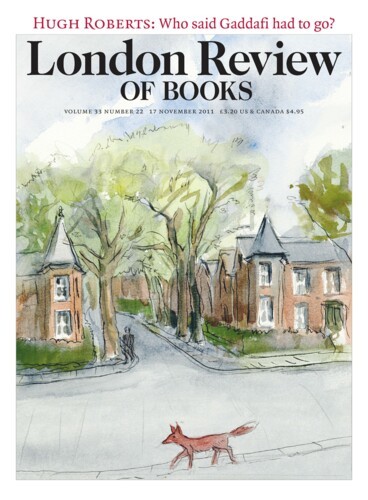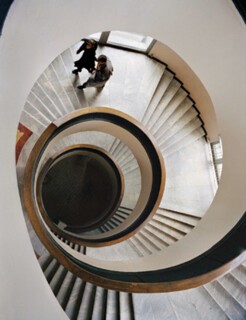Architecture had a shifting status within Russian modernism: first younger sibling, then domineering older brother. The riot of avant-garde experimentation and iconoclasm began in painting and literature in the years before the First World War; many totemic works date from this period – Malevich’s Black Square, Bely’s Petersburg, Goncharova’s Cyclist. The Revolution brought an accelerating radicalism in the arts, but the devastation of the Civil War years meant that this creative ferment found expression mostly on paper, canvas or plywood. It wasn’t until after 1921 that Russian architecture produced its great modernist landmarks. The following decade and a half brought an astonishing wave of formal innovation, driven at once by utopian energy and dire need; across the USSR, scores of buildings went up – apartment blocks, schools, garages, government offices, workers’ clubs – marked by a combination of elegance and austerity. By the mid-1930s, however, the Party had brought all the arts to heel, and avant-garde impulses were constrained or cancelled by the emerging stylistic canons of Socialist Realism. Architecture now became a privileged realm for the development of a Stalinist visual idiom: a heavy, bombastic classicism that still dominates the streetscape of many Russian cities, overshadowing the isolated remnants of the 1920s.
Building the Revolution, at the Royal Academy until 22 January, spans two extraordinary decades, 1915-35, and brings together an impressive range of paintings, drawings and photographs. Architecture is the main focus, represented both in archival images and Richard Pare’s remarkable photographs from the 1990s and 2000s; there is also a selection of works by artists such as Rodchenko, Popova, Lissitzky and others, demonstrating the extent to which the concerns of the different branches of the arts were intertwined in the period. Indeed, the previously separate disciplines of painting, sculpture, architecture and design were integrated after the Revolution, in institutions such as VKhUTEMAS (‘Higher Artistic and Technical Workshops’).
From an early stage, architectural thinking permeated the Russian avant-garde as a whole: notions of ‘construction’ played a central role in Popova’s Painterly Architectonics series – dynamic compositions of lines and irregularly shaped planes of vibrant colour. Perhaps the most celebrated example, however, is Tatlin’s planned monument to the Third International, a double helix of girders spiralling around stacked geometric forms. As a prelude to the exhibition, a ten-metre high model of Tatlin’s Tower has been installed in the stately Annenberg Courtyard (named for Nixon’s ambassador to the UK, ironically enough). Though the monument was never built, it found an echo in Shukhov’s radio tower of 1922, which consists of a series of steel hyperboloids; the angular perfection of its latticework was often deployed as a symbol for the modernity to which the USSR aspired.
In the Soviet architecture of the 1920s, a characteristically modernist attention to function and materials was combined with an urgent project of social transformation. Collective forms of living, eating, socialising and sleeping provided new parameters within which architects worked. The student housing designed by Ivan Nikolaev for the Textile Institute in Moscow in 1929-31 envisaged a communal existence, with shared dormitories and facilities. The building has a striking lightness to it: clean lines and an unadorned exterior with ramps for ease of circulation within. Above all, it is designed on a human scale, in stark contrast to the gigantism of high Stalinist constructions.
Of course, the avant-garde was not immune to the lure of the big statement: the 1929 Gosprom building in Kharkov, a series of severe-looking concrete and glass volumes connected by elevated walkways, encircles almost half of Ploshchad Svobody. But in many ways what is most impressive about the buildings of the period is the way they seek to make formal ingenuity practically useful. The bakery on Khodynskaia Street in Moscow, built by Georgi Marsakov in 1931, makes an aesthetic virtue of the production line, arranging the different stages of the process in a series of circles which in turn give the building its shape – form truly issuing from function.
More dazzling still is the work of Konstantin Melnikov, a maverick figure within the avant-garde best known for designing the USSR pavilion at the 1925 Paris Expo. Between 1927 and 1930, he built a remarkable series of garages and workers’ clubs – each of them an idiosyncratic one-off, as different from each other as from the buildings of Melnikov’s peers. The Rusakov club in north-eastern Moscow, built for the municipal workers’ union in 1927-29, consists of three cantilevered volumes fanning out from a central stage area; these three seating blocks could be used simultaneously and the stage subdivided various ways, allowing flexible use of the space. The Gosplan garage, built in 1936, combines the solid functionality of its main block with an expressive flourish reminiscent of art deco: a large circular window ringed with plasterwork fluting that gives it the appearance of an open eye.
The exhibition concludes with the Lenin mausoleum – a none too subtle metaphor for the entombment of avant-garde hopes. The successive versions of the mausoleum erected on Red Square between 1924 and 1930 seem to epitomise a more general transition from radical simplicity to leaden monumentalism: first a simple wooden box, then a larger but still unfussy wooden structure with steps leading to a viewing platform, followed by the familiar sombre pyramid whose marble and granite give it an air of geological permanence. But many of the buildings photographed by Pare go against the narrative of a straightforward death of the avant-garde, suggesting ambiguities and overlaps instead of a clear dividing line. The heavy Stalinist style did not emerge fully formed, but developed through a process of experiment and debate in which many avant-garde architects participated, attempting (with varying degrees of willingness) to find a visual language in which pared-down modernist forms could be deployed to meet the regime’s new demands. The result was a wave of curious hybrids in the mid-1930s, such as Miron Merzhanov’s Voroshilov Sanatorium in Sochi (1930-34), where classical columns line the approach to a building with curving, unadorned balconies projecting from a simple white block.
There is an elegiac quality to many of Pare’s photographs, which often depict sites that have long since lost their original function: abandoned factories, clubs for workers whose jobs no longer exist. Even where the buildings remain in use, they are generally in a state of decay which prompts concern about their future: El Lissitzky’s only surviving construction, the 1932 printworks of Ogonek magazine, was badly damaged by fire in 2008. Neglect has played a large role in this, but perhaps the greatest threat to the legacy of the avant-garde is from property developers, who have torn down one historic building after another, replacing them with fake replicas made from low-quality materials. This fate has most often been inflicted on buildings from the 18th or 19th centuries, but it has also struck the avant-garde: in 2008, Nikolaev’s communal student housing, derelict for some years, was stripped down to its steel skeleton, and new walls were attached. (The Moscow Architecture Preservation Society has produced two invaluable books on the recent wave of destruction.)
In other cases budding biznesmeny have defied conservation laws – doubtless with the aid of local officials – and colonised parts of buildings. Melnikov’s Rusakov club currently houses an Azeri restaurant, though it is supposedly closed for restoration work. Visiting the club this August, I saw that the estimated completion date for the restoration was October 2010; when I asked the concierge about the delay, she gave me a gold-toothed grin and told me to try coming back another year. Meanwhile letters have even fallen off the plaque saying ‘Architectural Monument: Protected by the Government.’
Although Pare’s photographs seem to capture the outcome of a long process of decline, it is striking how much the buildings have decayed in the years since many of the images were taken – as if the movement of time itself has quickened. It is true that the increasing pace of Russia’s capitalist transformation has brought an onrush of advertising – neon signs, billboards, banners, even slogans stencilled onto the pavement – which, along with constant construction work and seething road traffic, has crowded the visual environment like never before. Yet even amid all this, structures such as the Rusakov club have the uncanny effect of looking newer than their surroundings, the freshness of their forms belying the cracks in their plasterwork. It is as if they have travelled here from the future, accumulating dirt and damage on their way back to meet us.
Send Letters To:
The Editor
London Review of Books,
28 Little Russell Street
London, WC1A 2HN
letters@lrb.co.uk
Please include name, address, and a telephone number.


